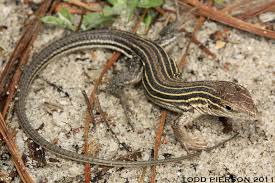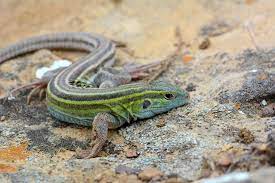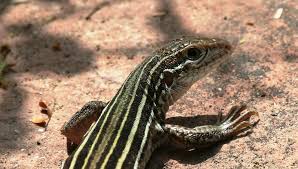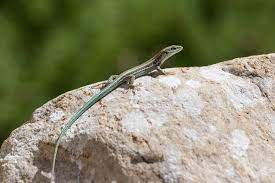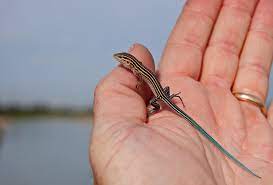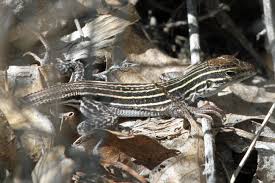It wasn’t that long ago (in geological time) that reptiles ruled Earth. They were the masters of their environment. On a recent hot Texas afternoon, a modern-day dinosaur was foraging for food. The sky above was thinly clouded as if by a trail of wood fire smoke. At nine-inches from head-to-tail, this six-lined racerunner was searching for a grasshopper, a cricket, or any form of protein. Then the primal instinctive part of him, the part ruled by his lizard brain, sensed danger. By the time the roadrunner was spotted, escape was a dicey affair—the hunter had suddenly become the hunted. The lizard exploded in a blurred flash, scrambling from obstacle to obstacle in a cloud of dust and scree. An instant later, the roadrunner stood with the reptile thrashing in its beak like a freshly caught minnow. The capture was especially fortuitous, given that six-lined racerunners can reach ground speeds of 18 mph. Unfortunately for the lizard, roadrunners can do 19 mph.
Take a quick look at this video, https://www.youtube.com/watch?v=FAUCprOHEYk , and I’m sure most of you’ll recognize the six-lined racerunner easily.
I can remember being a kid trying to catch a six-lined racerunner. It was no easy feat and, thus, great sport. It’s ironic that since the Mesozoic Era, most species of lizards have adapted to living with predators much larger than them. Most have adapted using camouflage, the ability to quickly climb trees, dive into holes or crawl into crevices to escape the jaws of death. To be sure, racerunners can do all these things but their claim to fame unquestionably comes from being fleet afoot. Namesake striping helps during a getaway because the horizontal lines blur together in motion, messing with the predator’s judgment of what’s moving where. Racerunners are not averse to heading for creeks or water to escape. As a final—and desperate—defensive move, racerunners can drop part or all of their tails. This distracts the pursuer by producing a second writhing entity, enabling the lizard to escape. There are specific downsides to this frantic act, but I feel certain survivors would agree it’s worth the cost. Tails eventually regrow.
It’s common to our part of the continent with 6 or 7 lines running down its back from head to tail. The lizard is typically found throughout much of the southeastern and south-central United States, from Maryland to Florida in the east, across the Great Plains to southern Texas and northern Mexico. It is typically dark green, brown, or black, with a white (female) or pale blue (male) underside. Males often have a pale green-colored throat. While racerunners come in many shades and colors, what really sets them apart from other lizards are large rectangular scales that form distinct transverse rows on their back, smaller granular scales underneath, and head scales that are separate from the skull bones. Naturally, racerunners have well-developed legs, but also a solid row of teeth on the jaw and a forked, snake-like tongue. They are slender bodied, with a tail nearly twice the body length. For juveniles, this tail is bright blue.
The 6-lined racerunner’s family (Teiidae) is a big one (approximately 150 species in 18 genera), with subfamilies found in both North and South America. They are collectively known as “whiptails,” including the racerunner. There are 46 species of whiptails in North America, 9 in Texas. There are three subspecies in all of North America, two of which are found in Texas: 1.) the Texas yellow-headed racerunner (Aspidoscelissexlineatus stephensae, Texas coast) and 2.) the western prairie racerunner (Aspidoscelis sexlineatus viridis,most everywhere else). The western prairie racerunner carries a 7th stripe and a bright green belly. They are often mistaken for five-lined skinks, which are black, shiny lizards with just 5 yellow stripes.
With the family tree somewhat sorted out, let’s examine behavior. In general, the species is wary, jerky, and quick-reflexed. Probably the most common characteristic these reptiles share (aside from physical traits) is aggressiveness. Racerunners have a complex sense of hierarchy based on size, where bigger is definitely better. As playground bullies of the reptile world, dominant racerunners will chase smaller ones and then follow up with a sharp bite for emphasis. During mating season, males practice “female tending.” This domestic abuse happens when the male repeatedly charges at a female trying to leave her burrow, thereby keeping her captive for himself.
Racerunners are equally aggressive hunters. Sleeping at night in their burrows, the species is active during daytime. When the racerunner has a full tummy, it will spend its afternoons basking in the sun. But as summer temperatures rise, racerunners take the afternoons off and do all their hunting before the hottest parts of the day. They scratch through leaf litter and loose soil for prey using their forked tongue to take in chemical cues from the environment. They use their pointed snout to probe and help sniff out their meals, which include mostly grasshoppers, crickets, ants, flies, termites, snails, caterpillars, and spiders. Of course, they can also become the meal for collared lizards, snakes, birds (especially roadrunners), and mammals such as skunks, badgers, and armadillos.
When they dig burrows, there are two entrances for easy access but one hole is plugged when they’re inside. These burrows serve as overnight sleeping quarters, to escape daytime heat, and as a place for females to lay eggs. Both Texas sub-species may use burrows to hibernate during cold winter months.
Courtship is a dramatic affair. Aside from the female tending behavior described above, males also perform their own version of “twerking,” by rubbing their pelvic region on the ground as they move toward the female. This is racerunner foreplay. Once the proper social displays have been performed, racerunner pairs mate in April through June. Pregnant females deposit one to six fertilized eggs in a specially dug brood burrow that can be up to a foot underground. If conditions are favorable, a second clutch of eggs may be laid once more over the summer, at least 3 weeks following the initial deposit. In two-months’ time, blue-tailed youngsters tunnel their way to the top to check out dry grasslands, woodlands, or coastal dunes that will become their new hunting grounds. Thus, the cycle of life has been fulfilled.
While most racerunner procreation is bi-sexual, there is one homosexual whiptail in extreme west Texas that reproduces from a population of all moms and no dads. As you can imagine, this is of great interest to biologists! As the state reptile of New Mexico, the New Mexico whiptail (Aspidoscelis neomexicanus) is not rare, but it is scarce in Texas. Actually, not all A. neomexicanus are homosexual; hence, they can be created either through two specific species cross breeding or through “parthenogenetic” reproduction of a single adult New Mexico whiptail. The hybridization of these two species prevents healthy males from forming, whereas males exist in both parent species. As for parthenogenesis, the resulting all female population is capable of asexual reproduction. Even though this is the only parthenogenetic species found in Texas, it is a reproductive strategy found in other whiptails in the Aspidoscelis genus.
With a sort of post-coital pride, this remarkable strain of “lesbian lizards” engages in its own form of mating behavior. A common theory is that the perfunctory act somehow stimulates ovulation because those that do not “mate” do not lay eggs (so many routes to joy, most of them detours). So how is this possible?
In sexual reproduction each parent provides half an offspring’s chromosomes. Generations of intermating shuffles the DNA deck providing a genetic diversity that helps offspring adapt to changing environments. The New Mexico whiptail’s eggs, before they form, gain twice the usual number of chromosomes during meiosis. This produces a standard pair of chromosomes derived from two sets of pairs. In other words, the eggs get a full chromosome count, thus providing the same genetic diversity over time rivaling that of offspring produced the old-fashioned way. There is nothing perfect, there is only life.
Dinosaurs and reptiles are so distant from our modern reality. The world of the 6-lined racerunner may seem foreign and strange to us, especially when it comes to asexual reproduction—that’s definitely unfamiliar. But the fact is, their lineage runs further back into history than ours. After millennia of our own evolution, we have grown apart from the very source of our own lives. Not the racerunner. It is as tied to the natural world today as its earliest ancestor was eons ago. Today we barely appreciate that every mouthful of food we eat and every lungful of air we breathe depends on nature. There’s a lesson we can learn from all racerunners: i.e., we belong to nature, so we should be a part of the world. . .and not an enemy of it.
By Larry Gfeller



